Menus
- Spectacular self-construction finished in just three months
- Triumph dragster ready to go after three months
- Do-it-yourself remained within 3000 euros
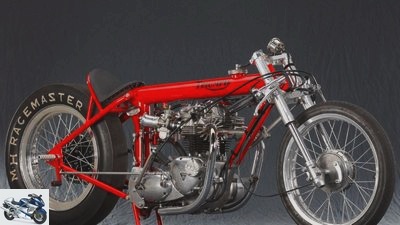
Bilski
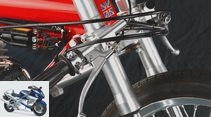
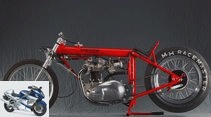
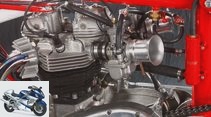
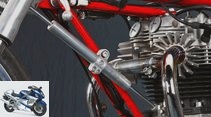
23 photos
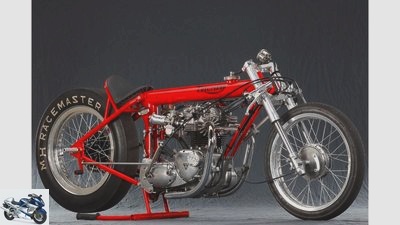
Bilski
1/23
Others move through the furniture stores to fulfill their wish for an unusual piece of furniture. Josef Hasenhundl prefers to go to his workshop.
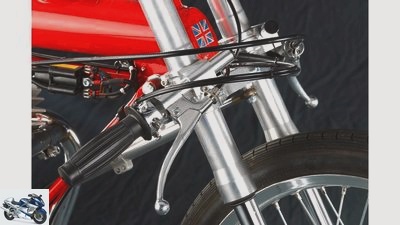
Bilski
2/23
Finding a fork with a 40 centimeter gap between the lower bridge and the wheel axle was difficult.
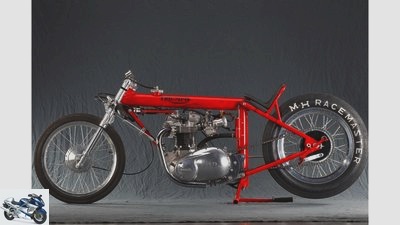
Bilski
3/23
A monkey tuner supplied the right part.
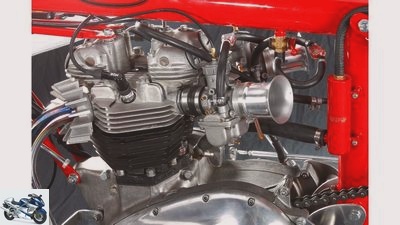
Bilski
4/23
Not just a show: the Triumph twin-cylinder, which has been drilled out to 750 cubic centimeters, gives classic tuning measures more steam. Josef made the front engine mounts himself from hydraulic pipes using pressing tools.

Bilski
5/23
The steering damper was donated by a 955 Daytona, …
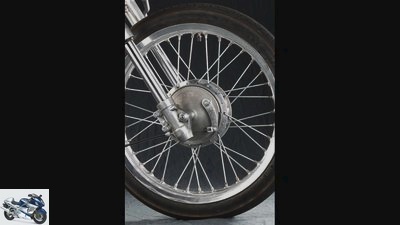
Bilski
6/23
… the small drum brake a Hercules K 50 RL.
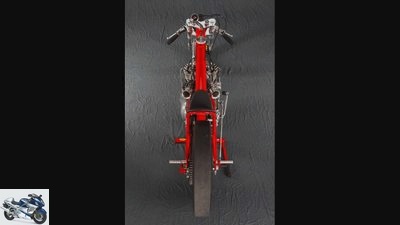
Bilski
7/23
Despite the tight budget, the self-construction with the many beautifully made details heralds the perfection of its creator.
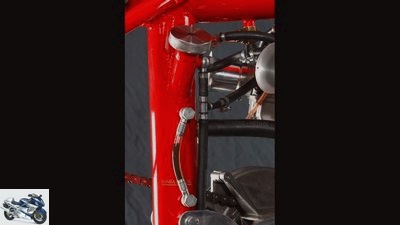
Bilski
8/23
Despite the simple construction, the self-made dragster offers the eye a lot of great details to linger, such as the oil tank with its level indicator.
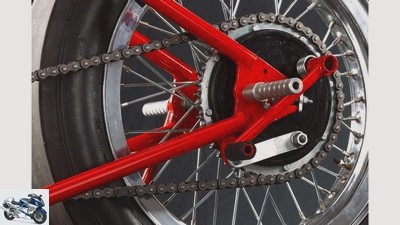
Bilski
9/23
The self-made brake lever directly actuates the cam on the half-hub drum.
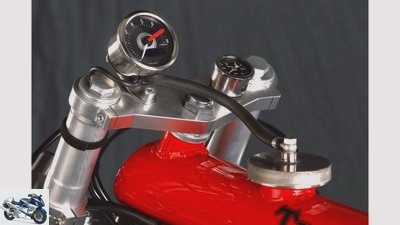
Bilski
10/23
Daytona tachometer with integrated oil temperature display. The dairy industry contributed the V4A tank cap.
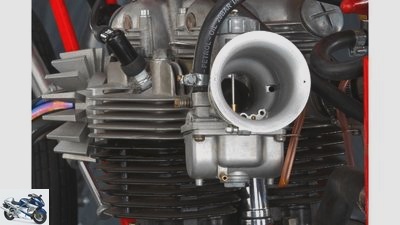
Bilski
11/23
Self-made Triumph dragster by Josef Hasenhundl.
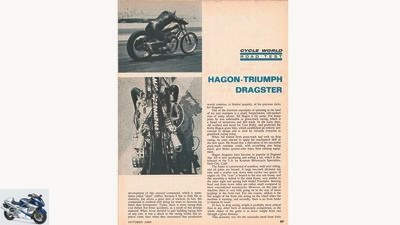
Bilski
12/23
Self-made Triumph dragster.
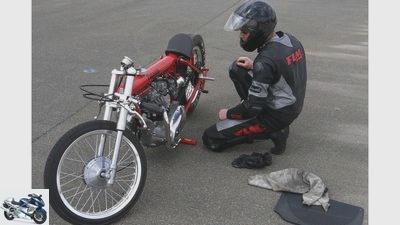
Bilski
13/23
Especially when it comes to English bikes. He knows the Triumph Twins inside out, regardless of whether they are unit or pre-unit generation.
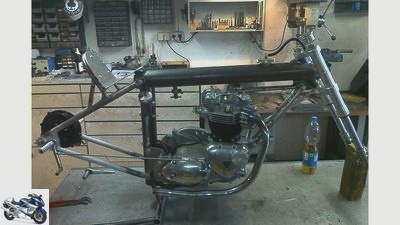
Bilski
14/23
He not only repairs and restores them, but also knows how to make them faster with classic tuning without affecting their stability.
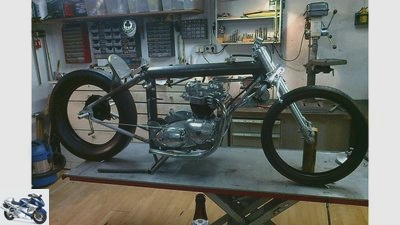
Bilski
15/23
So there was enough experience when the master industrial mechanic started building the Triumph dragster.
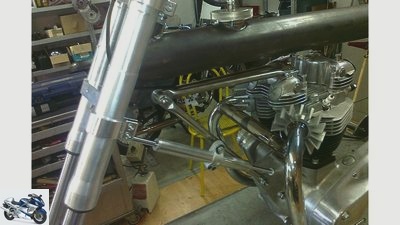
Bilski
16/23
But not a big budget: …
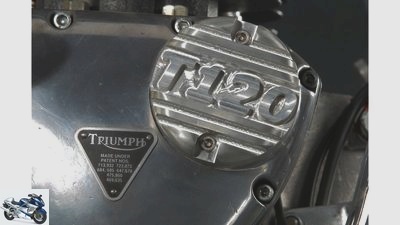
Bilski
17/23
The goal, from the start, was so original and …
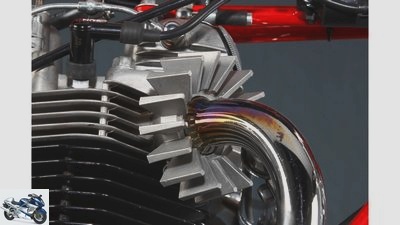
Bilski
18/23
to build as cheaply as possible, …
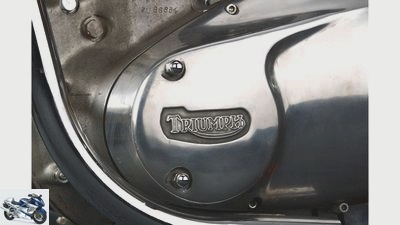
Bilski
19/23
… without giving up your own claim to perfection.
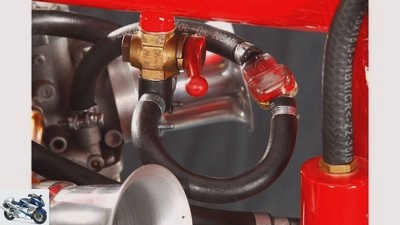
Bilski
20/23
The recreational wrench really did an excellent job.
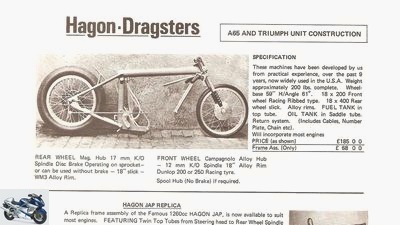
Bilski
21/23
The template: Dragster kit for Triumph Unit Twins in Alf Hagon’s 1971 catalog.
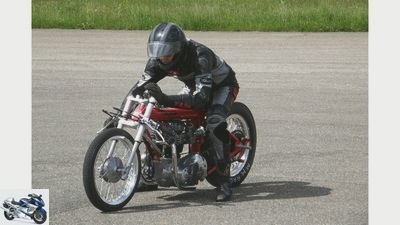
Bilski
22/23
The engine warms up for the first test ride. Josef checks the oil temperature before giving his Triumph dragster the spurs.
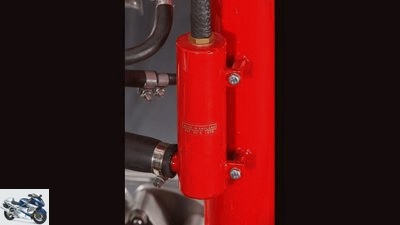
Bilski
23/23
Self-made Triumph dragster by Josef Hasenhundl.
Classic Triumph dragster
Spectacular self-construction finished in just three months
Content of
Others move through the furniture stores to fulfill their wish for an unusual piece of furniture. Josef Hasenhundl prefers to go to his workshop. And builds the very special seating furniture yourself. Like this Triumph dragster, which is not only an eye-catcher in the living room.
A.The story of this unusual self-construction began on a very ordinary evening last summer. While surfing the Internet, Josef Hasenhundl came across a photo that the passionate Triumph enthusiast could not get out of the head. The thing that captivated the anglophile mechanic was the photo of a classic dragster with a Triumph Unit engine.
Buy complete article

Classic Triumph dragster
Spectacular self-construction finished in just three months
"When I build, it is as original as possible"
Well, and just like that was still on the shelf of the 43-year-old master industrial mechanic. In his mind, the lathe and milling cutter were already warming up in the home workshop, while the Swabian worked deeper and deeper into the subject. In principle, the initial spark for the reproduction of such a Triumph dragster had already fallen. “When I saw the first photos and the simple construction of the dragster, I thought that I could build something like this myself with my skills and the local workshop equipment.”
At first, however, many hours went by researching the exact dimensions and chassis data of the dragster kit offered by Alf Hagon in the 1960s and early 70s. Because one thing was clear to Josef from the start: “When I build, then it is as original as possible. And for that I need a good template. ”It was finally found in the vast expanse of the World Wide Web. For example, the original Hagon catalog from those years, from which the dimensions for steering head angle, wheelbase, saddle height and ground clearance could be taken. The hobby designer then transferred this information to a DIN A3 photo of the side view of the original in order to put the missing dimensions into the correct proportions. In particular, this made it possible to determine the distance from the lower fork bridge to the wheel axle and the dimensions for the rigid frame rear. When the passionate screwdriver had gathered all the important data, he let his mates know over a beer. Although they were consistently impressed by the idea, they didn’t believe that their gifted friend would actually implement it.
Triumph dragster ready to go after three months
But in autumn 2012 the starting shot was given to set up the unusual vehicle, for which a place had already been reserved in the living room at home. But only for the winter, because it was always clear to the future dragster pilot that the self-construction had to be implemented in such a way that you could go on the track with it from time to time. However, without any sporting ambitions: “With around 55 hp you can’t do a lot anyway. It’s all about having fun, not about winning. “
Which doesn’t mean that the technology freak has no sporting ambitions. However, he mainly focuses on perfection in the technical implementation of his ideas. And the speed with which he pulls through such a project: just three months passed before the classic Triumph dragster was ready to go in the living room. “If I set myself up for something, then I do it consistently,” says the after-work mechanic, explaining his determination. Which also surprised the friends who “looked pretty stupid” when they stood in front of Josef’s spectacular self-construction after the short construction period.
It is truly a breathtaking appearance, reduced to the essentials, like the original from the late 1960s. In contrast to this, Josef’s work weighs a good 40 pounds more than the 94 kilogram model. No coincidence: “I deliberately built more stable because I wanted to be on the safe side.” That is why he welded the frame from three millimeter thick, seamlessly drawn boiler tubes from steam turbine construction. The top tube measures 90 millimeters and bunkers around 4.5 liters of fuel, while the 70 millimeter thick underframe has space for around 1.5 liters of oil.
Do-it-yourself remained within 3000 euros
The tank cap and oil cap come from the dairy industry, the telescopic fork from the Honda Monkey tuning accessories, the steering damper from a Triumph 955i Daytona and the front drum brake from a Hercules K 50 RL. He had the wheels spoked by a professional, everything else – for example engine mounts, rear frame with seat or the foot levers – Josef built, adjusted and finally painted it himself.
Only in this way did he manage to keep the costs for the self-construction within the planned range of a maximum of 3000 euros. Strictly speaking, this adds up to a further 3500 euros for overtaking and tuning the twin, which originally came from a 650 Bonneville, which has a 750 cubic set from Morgo, MAP aluminum rods milled from solid, full race intake and half race exhaust camshafts, 32 mm Mikunis and an electronic ignition from Boyer-Bransden help get things going. But the engine was – as mentioned – already on the shelf, carefully retracted over 4000 kilometers in a 1969 Bonnie.
In the meantime, the engine has passed its baptism of fire as a self-made dragster with flying colors. Let’s see what else Josef comes up with. The most extraordinary ideas come to him on very ordinary evenings.
Related articles
-
Driving report Triumph Thruxton R and Triumph Bonneville T120
triumph 20th photos triumph 1/20 The Thruxton has become a fine, classy cafe racer. triumph 2/20 Triumph Thruxton R triumph 3/20 Anyone looking for…
-
On the move: Triumph Bonneville and Yamaha TX 750
www. 40 photos , archive 1/40 When comparing the British original Triumph Bonneville 750 with the Japanese answer, the Yamaha TX…
-
Triumph Thunderbird Sport test
Triumph Thunderbird Sport test Yellow stunner No cafe racer: the high-torque retro classic from Triumph is far too good for short trips to the next ice…
-
fact Top test Triumph Speed Four Just 4 fun Are the English crazy? Tear off the paneling of the TT 600, make a garish street fighter with wild nostrils…
-
Moto Guzzi Audace, Triumph Thunderbird Commander and Victory Hammer S
Bilski 32 pictures Bilski 1/32 Strength meets glory and longing. It is the pure teaching of enjoying driving, taking off with …
-
Comparison test Suzuki TL 1000 S against Triumph Daytona T 595
Comparison test between Suzuki TL 1000 S and Triumph Daytona T 595 Wilde Herzen They are new, exciting, different. They have rough edges and two wild …
-
Comparison test Honda VFR against Triumph Sprint RS
Comparative test Honda VFR against Triumph Sprint RS Sprint rating Instantly crowned the star among sports tourers, the grim Triumph Sprint RS …
-
Comparison test Ducati 996 S, Honda CBR 900 RR, Triumph Daytona 955i
PhotoGargolov comparison test Ducati 996 S, Honda CBR 900 RR, Triumph Daytona 955i Strategy games Four wins? Or would you rather be quick with three? …
-
Comparison test all-rounder Honda Hornet 900, Triumph Speed Triple, Yamaha FZS 1000 Fazer
Comparison test of all-rounders Honda Hornet 900, Triumph Speed Triple, Yamaha FZS 1000 Fazer Free radicals Undisguised, light and strong: Honda Hornet 900 ….
-
Concept comparison Yamaha TDM vs. BMW R 1150 RT, Honda Hornet and Triumph Tiger
Jahn concept comparison Yamaha TDM vs. BMW R 1150 RT, Honda Hornet and Triumph Tiger Three in one? One for all ?? or all nothing? Yamaha has a new …